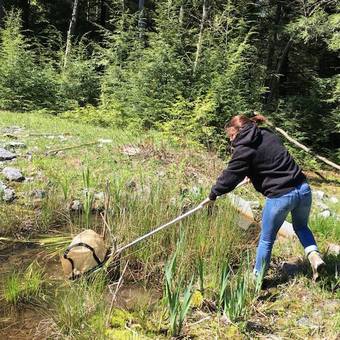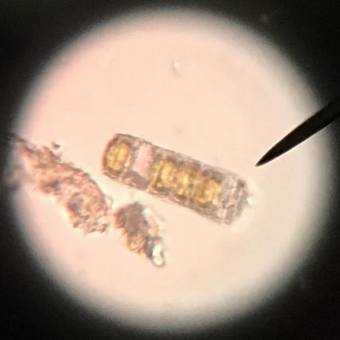SFU Biology Students Search for Diversity in Polluted Waters
Have you ever come across a stream or pond that was full of a thick, murky, orange sludge? You likely saw a case of Abandoned Mine Drainage (AMD) pollution. AMD occurs when acidic, metal-rich water emerges at the surface after passing through abandoned coal or clay mines. These metals then precipitate in a thick, orange sludge called “yellow boy” that can smother life in streams and ponds.

This summer, two teams of SFU Biology students studied the effects of pollution on freshwater biodiversity. Dr. Lane Loya and Dr. Justin Merry teamed with a group of four biology students as well as faculty in the Environmental Engineering department to study whether passive AMD remediation systems were effective in creating habitat.
Passive AMD systems typically involve a series of retention ponds that catch AMD sediment before it enters waterways, and are connected by small limestone-lined channels that buffer the pH. The SFU team sampled aquatic insect communities in six AMD remediation sites around Cambria and Somerset counties, along with several control sites. The samples were brought back to the lab for identification, allowing the researchers to compare species diversity and abundance within AMD sites to unaffected sites. Preliminary data analysis indicates that, despite often still having visible yellow boy present, AMD remediation sites did create insect habitat that possessed good species richness and diversity.

Another Biology research team studied other kinds of water pollution. Dr. Irene Wolf and Mr. Andrew Scanlan led a group of four students on a project that investigated whether diatom species could be used as environmental indicators in streams. “We were attempting to find a link between the health of the stream and which diatom species were present,” explained Junior Alayna Hawkins, one of four biology students who worked on the project. Diatoms were identified to species level and placed into environmental indices for nitrogen and phosphorus levels to assess stream health.
“A long term goal of this project is to grow and isolate diatom species’ DNA for sequencing,” explained Mr. Scanlan. “The purpose of the sequencing is to examine if diatoms that differ in their morphology and affinity for different nutrients share similar DNA, and if this will affect their classification as indicator species for nutrient pollutants.” Students working on the project will get to experience field collection, the challenge of raising species in the lab, as well as molecular methods involved in DNA extraction, sequencing, and annotation.
These were more just summer jobs for the eight students involved in these projects. “I have always enjoyed being outside, but I honestly had no idea about the diversity of invertebrates,” reflected Junior Alyssa Rozich, who worked on the AMD project. “There is something really unique about being in the field with a group of students and professors who share similar interests and are all working towards a common goal.”
This project was supported by the Center for Watershed Research and Service, as well as internal funds from the Biology Department at Saint Francis University. Alyssa Bartlebaugh, Jade Canak, Alyssa Rozich, and Gabriella Scott worked with Dr. Lane Loya and Dr. Justin Merry on the AMD biodiversity project. Cassandra Asberry, Alayna Hawkins, Katherine Meurer, and Colleen Naeger worked with Dr. Irene Wolf and Mr. Andrew Scanlan on the diatom project.